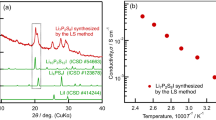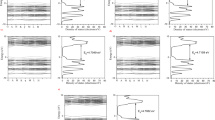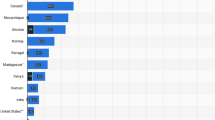Abstract
In this study, the lanthanide-doping (Ce3+, Sm3+, Eu3+ and Tb3+) effects on the formation of leucite (KAlSi2O6) by sol-gel synthesis were investigated. The phase purity and morphological properties of lanthanide-doped specimens have been estimated. The proposed sol-gel synthesis route is suitable for the preparation of mixed leucite-kalsilite ceramics doped with Sm3+, Eu3+ and Tb3+ (up to 10 M %). This simple and successful synthetic approach offers a feasible way to obtain lanthanide-doped potassium alumosilicate ceramics with possible application in odontology. The synthesis products were characterized using thermal analysis (TG/DTA), X-ray powder diffraction (XRD) analysis, infrared spectroscopy (FTIR) and scanning electron microscopy (SEM). Moreover, the optical properties of lanthanide-doped synthesis products were also investigated.

The luminescence spectrum of Eu3+-doped (5 mol%) leucite-kalsilite sample consists of broad lines associated with 5D0 → 7F0–4 transition (570–710 nm, orange-red region) of Eu3+ ions with the hypersensitive line at 616 nm.
Similar content being viewed by others
References
Kaur S, Bala N, Khosla C (2019) Investigations of thermal sprayed HAP and HAP-TiO2 composite coatings for biomedical applications. Anti-Corros Methods Mater 66:74–87
Abumanhal M, Ben-Cnaan R, Feldman I, Keren S, Leibovitch I (2019) Polyester urethane implants for orbital trapdoor fracture repair in children. J Oral Maxillofac Surg 77:126–131
Best SM, Porter AE, Thian ES, Huang J (2008) Bioceramics: past, present and for the future. J Eur Ceram Soc 28:1319–1327
Avnir D, Coradin T, Lev O, Livage J (2006) Recent bio-applications of sol-gel materials. J Mater Chem 16:1013–1030
Cabal B, Malpartida F, Torrecillas R, Hoppe A, Boccaccini AR, Moya JS (2011) The development of bioactive glass-ceramic substrates with biocide activity. Adv Eng Mater 13:B462–B466
Gao A, Hang RQ, Huang XB, Zhao LZ, Zhang XY, Wang L, Tang B, Ma SL, Chu PK (2014) The effects of titania nanotubes with embedded silver oxide nanoparticles on bacteria and osteoblasts. Biomater 35:4223–4235
Shah FA, Thomsen P, Palmquist A (2018) A review of the impact of implant biomaterials on osteocytes. J Dent Res 97:977–986
Jia ZJ, Zhou WH, Yan JL, Xiong P, Guo H, Cheng Y, Zheng YF (2019) Constructing multilayer silk protein/nanosilver biofunctionalized hierarchically structured 3D printed Ti6Al4 V scaffold for repair of infective bone defects. ACS Biomater Sci Eng 5:244–261
Vallet-Regi M (2001) Ceramics for medical applications. J Chem Soc Dalton Trans:97–108
Hench LL, Paschall HA (1973) Direct chemical bond of bioactive glass-ceramic materials to bone and muscle. J Biomed Mater Res 7:25–42
Kelly JR (1997) Ceramics in restorative and prosthetic dentistry. Annu Rev Mater Sci 27:443–468
Thomsen RM, Skibsted J, Yue YZ (2018) The charge-balancing role of calcium and alkali ions in per-alkaline aluminosilicate glasses. J Phys Chem B 122:3184–3195
Barreiro MM, Vicente EE (1993) Kinetics of isothermal phase-transformations in a dental porcelain. J Mater Sci Mater Med 4:431–436
Kruzic JJ, Arsecularatne JA, Tanaka CB, Hoffman MJ, Cesar PF (2018) Recent advances in understanding the fatigue and wear behavior of dental composites and ceramics. J Mech Behav Biomed Mater 88:504–533
Souza JCM, Nascimento RM, Martinelli AE (2010) Characterization of dental metal-ceramic interfaces immersed in artificial saliva after substructural mechanical metallization with titanium. Surf Coat Technol 205:787–792
Assmann S, Ermrich M, Kunzmann K (2001) High-temperature X-ray diffraction analysis of a low-fusing dental ceramic. J Mater Sci 36:5403–5406
Li XX, Shaw LL (2007) Formation of leucite-free zone in laser densified dental porcelains. Mater Lett 61:3946–3950
Kelly JR, Benetti P (2011) Ceramic materials in dentistry: historical evolution and current practice. Aust Dent J 56:84–96
Holand W, Rheinberger V, Apel E, van't Hoen C (2007) Principles and phenomena of bioengineering with glass-ceramics for dental restoration. J Eur Ceram Soc 27:1521–1526
Kukiattrakoon B, Hengtrakool C, Kedjarune-Leggat U (2010) Degradability of fluorapatite-leucite ceramics in naturally acidic agents. Dent Mater J 29:502–511
Fredericci C, Yoshimura HN, Molisani AL, Pinto MM, Cesar PF (2011) Effect of temperature and heating rate on the sintering of leucite-based dental porcelains. Ceram Int 37:1073–1078
Goudouri OM, Kontonasaki E, Papadopoulou L, Kantiranis N, Lazaridis NK, Chrissafis K, Chatzistavrou X, Koidis P, Paraskevopoulos KM (2014) Towards the synthesis of an experimental bioactive dental ceramic. Part I: crystallinity characterization and bioactive behavior evaluation. Mater Chem Phys 145:125–134
Ritzberger C, Schweiger M, Holand W (2016) Principles of crystal phase formation in Ivoclar Vivadent glass-ceramics for dental restorations. J Non-Cryst Solids 432:137–142
Maggetti M, D'Albis A (2017) Phase and compositional analysis of a Sevres soft paste porcelain plate from 1781, with a review of early porcelain techniques. Eur J Mineral 29:347–367
Paukov IE, Belitsky IA, Fursenko BA (2002) Heat capacity and thermodynamic functions of leucite at low temperatures. Thermochim Acta 387:23–28
Palmer DC, Salje EKH (1990) Phase-transitions in leucite – dielectric properties and transition mechanism. Phys Chem Miner 17:444–452
Zhang Y, Lv M, Rao PG, Shui AZ (2007) Quantitative XRD analysis of hydrothermally-derived leucite content in dental porcelain ceramics. J Ceram Soc Jpn 115:329–332
Kohoutkova M, Klouzkova A, Kostka P, Mrazova M (2008) Synthesis and characterization of an amorphous precursor for leucite dental ceramics. J Non-Cryst Solids 354:741–748
Klouzkova A, Mrazova M, Kohoutkova M (2007) Synthesis of partially stabilized leucite. J Phys Chem Solids 68:1207–1210
Klouzkova A, Mrazova M, Kohoutkova M, Klouzek J (2013) Leucite dental ceramics. Chem List 107:856–861
Farrukh MA, Naseem F, Imtiaz A, Khaleeq-ur-Rahman M, Martins TD, Zia KM (2016) Hydrothermal synthesis of leucite nanoparticles using anionic surfactant: structural evaluation and catalytic properties. Russ J Phys Chem A 90:1231–1237
Cattell MJ, Chadwick TC, Knowles JC, Clarke RL, Samarawickrama DYD (2006) The nucleation and crystallization of fine grained leucite glass-ceramics for dental applications. Dent Mater 22:925–933
Chen XH, Chadwick TC, Wilson RM, Hill RG, Cattell MJ (2011) Crystallization and flexural strength optimization of fine-grained leucite glass-ceramics for dentistry. Dent Mater 27:1153–1161
Chen X, Chadwick TC, Wilson RM, Hill R, Cattell MJ (2010) Crystallization of high-strength fine-sized leucite glass-ceramics. J Dent Res 89:1510–1516
Tosic MB, Dimitrijevic RZ, Mitrovic MM (2002) Crystallization of leucite as the main phase in glass doped with fluorine anions. J Mater Sci 37:2293–2303
Li J, Duan JX, Hou L, Lu ZY (2018) Effect of Cs content on K1-xCsxAlSi2O6 ceramic solidification forms. J Nucl Mater 499:144–154
Bogdanoviciene I, Jankeviciute A, Pinkas J, Beganskiene A, Kareiva A (2008) Study of alumosilicate porcelains: sol-gel preparation, characterization and erosion evaluated by gravimetric method. Mater Res Bull 43:2998–3007
Zhang Y, Wu JQ, Rao PG, Lv M (2006) Low temperature synthesis of high purity leucite. Mater Lett 60:2819–2823
Hashimoto S, Sato F, Honda S, Awaji H, Fukuda K (2005) Fabrication and mechanical properties of sintered leucite body. J Ceram Soc Jpn 113:488–490
Zhang Y, Lv M, Chen DD, Wu JQ, Rao PG (2007) Leucite crystallization kinetics with kalsilite as a transition phase. Mater Lett 61:2978–2981
Xie N, Bell JL, Krivenw WM (2010) Fabrication of structural leucite glass-ceramics from potassium-based geopolymer precursors. J Am Ceram Soc 93:2644–2649
Annapurna K, Dwivedi RN, Kumar A, Chaudhuri AK, Buddhudu S (2000) Temperature dependent luminescence characteristics of Sm3+-doped silicate glass. Spectrochim Acta A Mol Biomol Spectrosc 56:103–109
Chimalawong P, Kaewkhao J, Kedkaew C, Limsuwan P (2010) Optical and electronic polarizability investigation of Nd3+-doped soda-lime silicate glasses. J Phys Chem Solids 71:965–970
Eslami M, Hamnabard Z, Ali N (2013) Synthesis and spectral properties of Nd-doped glass-ceramics in SiO2-CaO-MgO system prepared by sol-gel method. J Rare Earths 31:595–599
Rego FG, Dantas NO, Silva ACA, Vermelho MVD, Jacinto C, Gouveia-Neto AS (2017) IR-to-visible frequency upconversion in Yb3+/Tm3+ co-doped phosphate glass. Opt Mater 73:1–6
Sobczyk M, Marek L (2019) Comparative study of optical properties of Ho3+ −doped RE2O3-Na2O-ZnO-TeO2 glasses. J Lumin 206:308–318
Sontakke AD, Biswas K, Annapurna K (2009) Concentration-dependent luminescence of Tb3+ ions in high calcium aluminosilicate glasses. J Lumin 129:1347–1355
Sun T, Li R, Chen JJ, Mao ZY, Wang YZ, Wang DJ (2016) Photoluminescent properties and thermal stability of F-modified aluminosilicate phosphor for solid-state lighting. J Mater Sci Mater Electron 27:906–912
Kaky KM, Lakshminarayana G, Baki SO, Lira A, Caldino U, Meza-Rocha AN, Falcony C, Kityk IV, Taufiq-Yap YH, Halimah MK, Mahdi MA (2017) Structural and optical studies of Er3+-doped alkali/alkaline oxide containing zinc boro-aluminosilicate glasses for 1.5 mu m optical amplifier applications. Opt Mater 69:401–419
Assadi AA, Herrmann A, Tewelde M, Damak K, Maalej R, Russel C (2018) Tb3+ as a probe for the molecular structure of mixed barium magnesium alumino silicate glasses. J Lumin 199:384–390
Righini GC, Ferrari M (2005) Photoluminescence of rare-earth-doped glasses. Riv Nuovo Cimento 28:1–53
Wang X, Hu LL, Meng XG, Li HM, Wang SK (2018) Effect of Al2O3 and La2O3 on structure and spectroscopic properties of Nd-doped sol-gel silica glasses. J Lumin 204:554–559
Wu YT, Qiu KH, Tang QX, Zhang WT, Wang JL (2018) Luminescence enhancement of Al3+ co-doped Ca3Sr3(VO4)4:Eu3+ red-emitting phosphors for white LEDs. Ceram Int 44:8190–8195
Fanai AL, Khan U, Rai S (2019) Luminescence enhancement of Pr3+ doped sol-gel silica glass as a result of Al3+ co-doping. J Non-Cryst Solids 503:89–93
Jankeviciute A, Kareiva A (2011) Synthesis and characterization of leucite ceramics using sol-gel derived molecular precursors. Mendeleev Commun 21:287–288
Sinusaite L, Grigoraviciute-Puroniene I, Popov A, Ishikawa K, Kareiva A, Zarkov A (2019) Controllable synthesis of tricalcium phosphate (TCP) polymorphs by wet precipitation: effect of washing procedure. Ceram Int 45:12423–12428
Deliormanli AM, Yildirim M (2016) Sol-gel synthesis of 13-93 bioactive glass powders containing therapeutic agents. J Aust Ceram Soc 52:9–19
Shi QS, Kang JF, Qu Y, Liu SQ, Khater GA, Li S, Wang YL, Yue YL (2018) Effect of rare-earth oxides on structure and chemical resistance of calcium aluminophosphate glasses. J Non-Cryst Solids 491:71–78
Grigoraviciute-Puroniene ZA, Tsuru K, Ishikawa K, Kareiva A (2019) A novel synthetic approach for the calcium hydroxyapatite from the food products. J Sol-Gel Sci Technol 91:63–71
Haque FZ, Nandanwar R, Singh P, Dharavath K, Syed FF (2018) Effect of different acids and solvents on optical properties of SiO2 nanoparticles prepared by the sol-gel process. Silicon 10:413–419
Izadifar M, Koeniger F, Gerdes A, Woell C, Thissen P (2019) Correlation between composition and mechanical properties of calcium silicate hydrates identified by infrared spectroscopy and density functional theory. J Phys Chem C 123:10868–10873
Ahmadi Z, Moztarzadeh F (2018) Synthesizing and characterizing of gelatin-chitosan-bioactive glass (58s) scaffolds for bone tissue engineering. Silicon 10:1393–1402
Wiglusz RJ, Grzyb T, Lis S, Strek W (2009) Preparation and spectroscopy characterization of Eu:MgAl2O4 nanopowder prepared by modified Pechini method. J Nanosci Nanotechnol 9:5803–5810
Skaudzius R, Enseling D, Skapas M, Selskis A, Pomjakushina E, Juestel T, Kareiva A, Ruegg C (2016) Europium-enabled luminescent single crystal and bulk YAG and YGG for optical imaging. Opt Mater 60:467–473
Skruodiene M, Katelnikovas A, Vasylechko L, Skaudzius R (2019) Tb3+ to Cr3+ energy transfer in a co-doped Y3Al5O12 host. J Lumin 208:327–333
Smalenskaite S, Salak AN, Ferreira MGS, Skaudzius R, Kareiva A (2018) Sol-gel synthesis and characterization of hybrid inorganic-organic Tb(III)-terephthalate containing layered double hydroxides. Opt Mater 80:186–196
Rozman N, Tobaldi DM, Cvelbar U, Puliyalil H, Labrincha JA, Legat A, Skapin AS (2019) Hydrothermal synthesis of rare-earth modified titania: influence on phase composition, optical properties, and photocatalytic activity. Materials 12:713
Ahmed HAAS, Ntwaeaborwa OM, Kroon RE (2013) High efficiency energy transfer in Ce,Tb co-doped silica prepared by sol-gel method. J Lumin 135:15–19
Shen YQ, Qiu KH, Wang JL, Zhang WT, Tang QX (2017) Synthesis of Dy3+ co-doped Bi4Si3O12:Sm3+ phosphors with enhanced red-emitting properties. Ceram Int 43:15946–15951
Pavasaryte L, Katelnikovas A, Klimavicius V, Balevicius V, Momot A, Van Bael MK, Hardy A, Kareiva A (2018) Eu3+ − doped Y3-xSmxAl5O12 garnet: synthesis and structural investigation. New J Chem 42:2278–2287
Acknowledgments
AK would like to express sincere gratitude for Fellowship administrated by The Japan Society for the Promotion of Science (JSPS). Fellow’s ID No.: L12546.
Author information
Authors and Affiliations
Corresponding author
Ethics declarations
Conflict of Interest
The authors declare that they have no conflict of interest.
Additional information
Publisher’s Note
Springer Nature remains neutral with regard to jurisdictional claims in published maps and institutional affiliations.
Highlights
• The lanthanide-doped leucite samples were synthesized using sol-gel synthesis route.
• Leucite-kalsilite ceramics doped with Sm3+, Eu3+ and Tb3+ were obtained.
• Contraray, the single-phase undoped leucite ceramic was obtained at 1000 °C.
• Luminescent properties of lanthanide-doped ceramics were investigated.
• Lanthanide-doped potassium alumosilicate ceramics could be applied in odontology.
Rights and permissions
About this article
Cite this article
Sabaliauskiene, A., Beganskiene, A., Ishikawa, K. et al. Lanthanide-Doping Effects on the Formation of Leucite KAlSi2O6. Silicon 12, 1213–1223 (2020). https://doi.org/10.1007/s12633-019-00223-4
Received:
Accepted:
Published:
Issue Date:
DOI: https://doi.org/10.1007/s12633-019-00223-4




